Copyright Anchorage Daily News

Like so much else in the U.S. economy, the housing industry is realizing that it pays to chase luxury these days. Even in a market that’s famously unaffordable, buyers looking for high-end finishes and communities with golf courses and pickleball courts are willing to pay up. At the entry level, price is the only differentiator. What is a savvy builder to do? Migrate toward the higher end of the market, of course. That’s the scenario likely to play out as the fortunes of wealthy households and working-class Americans diverge in an economy where the stock market is booming, but the labor market is sluggish. The near-term implications are a slowdown in the construction of entry-level homes; hardly what’s needed to improve affordability. But what’s often missed is that, in the longer term, all building is good building: More luxury housing will have the effect of putting on the market more 20- and 30-year-old starter homes being vacated by millennials ready for an upgrade. For now, million-dollar-plus homes are the fastest growing part of the resale market, up 20% in September from a year earlier, followed by homes in the $750,000 to $1 million range. Three large, publicly traded developers spoke to how this divergence is playing out in the new-builds market during their recent quarterly earnings updates. PulteGroup Inc. said that net new orders from first-time buyers were down 14% year over year. Orders from move-up buyers were down 3%, while those from active adults (think 55 and older) climbed 7%. “Weaker consumer confidence and stretched affordability are limiting opportunities with first-time buyers,” Pulte’s Chief Executive Officer Ryan R. Marshall said. Taylor Morrison Home Corp., for its part, noted that its positioning at the higher end of the market has been a source of resilience. About 70% of the builder’s sales derive from move-up or “resort lifestyle” buyers, which explains its average selling price of $602,000. Compare that to an entry-level builder like Lennar Corp. with an average selling price of $383,000. Taylor Morrison’s Chief Executive Officer Sheryl Palmer said the company has “a price-focused approach to drive volume, especially where we serve predominantly first-time buyers,” while it can be “more patient to protect values,” with its more affluent communities. Profit margins in the resort-lifestyle segment are “typically the highest kind in the portfolio,” Chief Financial Officer Curt Vanhyfte said. Last week, DR Horton Inc., the largest homebuilder in the U.S. focused on first-time homebuyers, repeated the message of sluggishness that the rest of the industry has talked about. Use of incentives, including mortgage-rate buydowns, increased again in the quarter, and DR Horton cut the number of homes started in its subdivisions by an average of 30%. Notably, the company said it’s leaning more on buying mortgage rates down to as low as 3.99%, speaking to just how low rates need to be to motivate buyers. The divergence between the low- and high-end of the market shouldn’t be a surprise given how the economy is evolving. Higher-end homeowners typically have substantial levels of home equity accumulated over the years, healthy stock market portfolios and high incomes. Interest rates are generally less important to this group when it comes to buying relative to lifestyle choices and economic confidence. Entry-level buyers don’t have that home-equity cushion, have smaller financial portfolios, and are more constrained by their incomes, mortgage rates and overall affordability. It’s also harder for builders to profitably serve these buyers - they can make homes smaller, with cheaper appliances and finishes, but the price per unit of lumber and labor is the same whether you’re building a $300,000 home or a million-dollar home. When the market is healthy, a high volume of transactions can defray some costs, but not right now. While homebuilders are hopeful that lower mortgage rates will revive first-time buyer demand in 2026, any improvement is more likely to benefit the higher-end of the market. Demographic trends also support focusing more on older, wealthier Americans. In a research piece published earlier this year, John Burns Research & Consulting forecast that in the decade ending 2034, the number of Americans between the ages of 40 and 54 will increase by 6.9 million while the number between the ages of 25 and 39 will increase by just 1.5 million. This is a function of the large millennial generation aging into its move-up years while the smaller Gen Z cohort enters its first-time homebuying years. A pickup in housing market conditions that leads millennials to upgrade to bigger homes would free up their smaller homes for would-be Gen Z buyers. We’ve seen this shift toward the higher end in the multi-family sector already, where construction in the 2010s catered more to the high end. In Atlanta, for instance, 94% of apartments built between 2012 and 2021 were considered luxury units. A similar directional shift in new single-family home sales might create angst among policymakers and politicians about an economy tilting even more towards the rich, but that’s missing the point. The key is that more housing has broad-based benefits regardless of what kind gets built. The rental housing economist Jay Parsons recently noted that in the highest-supplied metro markets, rents in Class C apartments (the lower end of the market) are getting crushed. A relatively better outlook for higher-end housing means that renters hoping to buy an entry-level home in 2026 are less likely to end up with that new home smell. Conor Sen is a Bloomberg Opinion columnist. He is founder of Peachtree Creek Investments.



